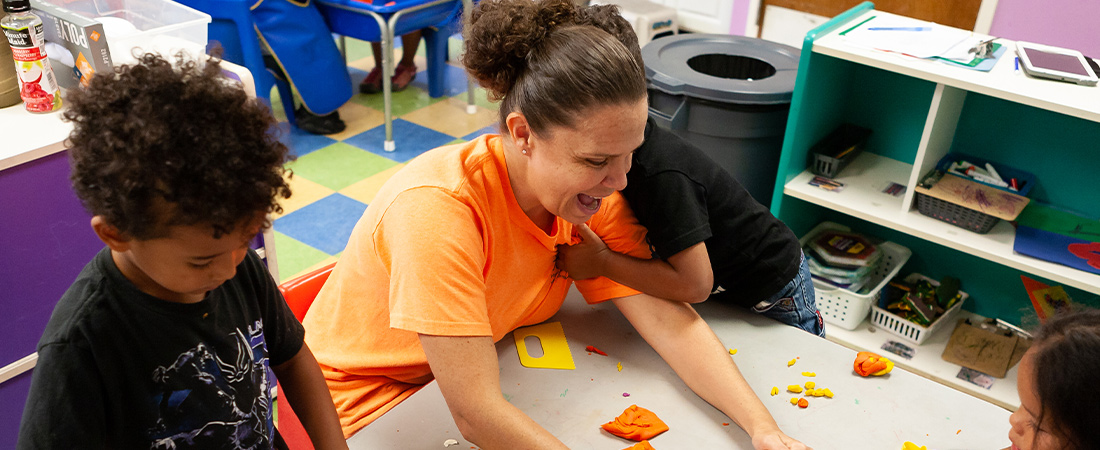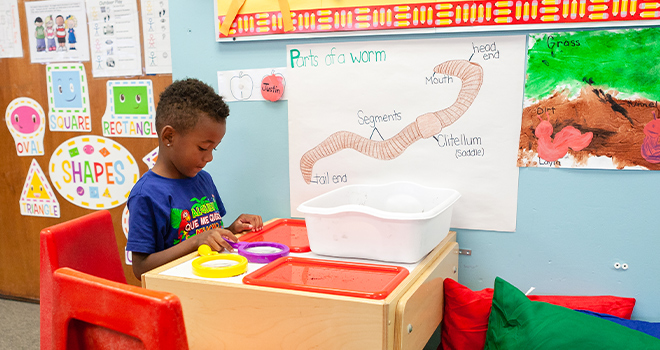Improving Outcomes for Children

EDC is helping preschool teachers like Harley Cronshaw improve their classroom practice.
It’s 3:30 on a Tuesday afternoon, and before preschool teacher Harley Cronshaw can exit her classroom, she has to negotiate all the hugs.
“I’ll be back tomorrow!” Cronshaw says, a wide smile on her face as she says goodbye to her co-teacher and hugs each of her preschoolers. As she turns to leave, one more child comes up to her. Another embrace. It’s a nice way to end the work day.
After 19 years as a teacher, Cronshaw still loves the ups and downs of working with young children at The Children’s Workshop (TCW) in Central Falls, Rhode Island. She knows she is making a difference. But like most of the other preschool and early childhood teachers at TCW, she doesn’t have a degree in education, and her instruction may not always align with best practices in early learning. This is one of the factors that contributes to the two-star (out of five) quality rating awarded to TCW by the Rhode Island Department of Education.
So tonight, after a full day of teaching, Cronshaw arrives back at school—dinner in hand—to take a class offered by EDC’s Center for Early Learning Professionals (the Center). The subject? How to improve classroom spaces and environments.
The topic is important because the space in which children spend their time contributes to how, and what, they learn. Details such as the softness of pillows or the height of a chair or the placement of posters on a wall can all impact learning. So when teachers rework reading nooks or science areas to better align with best practices in classroom setup, they are also helping to raise the quality of education that children receive.
EDC’s Lori Coletti, one of the facilitators for the class, says that these types of small changes in teaching practice can make a big difference in the quality of education that young children receive.
“The real goal is for improved outcomes for kids,” says Coletti.
Supporting teachers
Based in Warwick, the Center is helping the R.I. Department of Human Services achieve its goal of improving early childhood education across the state, especially among dual language learners and children who live in poverty. The Center does this by offering professional development courses, such as the course that Cronshaw is taking, as well as direct assistance to programs such as TCW.
EDC’s Brenda Potter, who directs the Center, estimates the Center offers professional development opportunities to approximately 90 percent of the child-care programs across Rhode Island. The Center is also reaching about 80 percent of programs with broader school improvement activities, such as helping administrators create program-wide quality improvement plans and assisting teachers in building individual professional development plans. These activities help schools improve their quality rating—and the higher the rating, the more state money the program receives for each subsidy-eligible child they enroll. (Programs use these extra funds to pay teachers and purchase needed materials.)
Behind all of the Center’s activities is a mind-set of helping early childhood programs continuously improve, says Potter. She adds that TCW is exactly the kind of school that the Center wants to support.
“TCW is motivated to improve their quality rating, and they have a lot of systems in place to support that,” Potter says. “They have a vision for what they want to achieve, and the addition of our services can really help them move that vision along.”
Kristin Lariviere, education coordinator at TCW, encourages all of her preschool teachers to take the Center course so that they understand what constitutes a high-quality classroom environment. She has been impressed with the results.
“Staff are now looking at [classrooms] through a high-quality lens,” says Lariviere. “That wasn’t happening before. They’ve gotten so excited about changing their classrooms.”
Cronshaw enjoys the opportunities to learn new teaching strategies, too, especially because being in a classroom with young children doesn’t always leave much time for quiet self-reflection. And she’s also driven to keep improving as an educator for the sake of her students.
“You literally see the Aha! moments in them when they learn something new,” she says. “You know what you’re doing is making a difference in their lives.”
